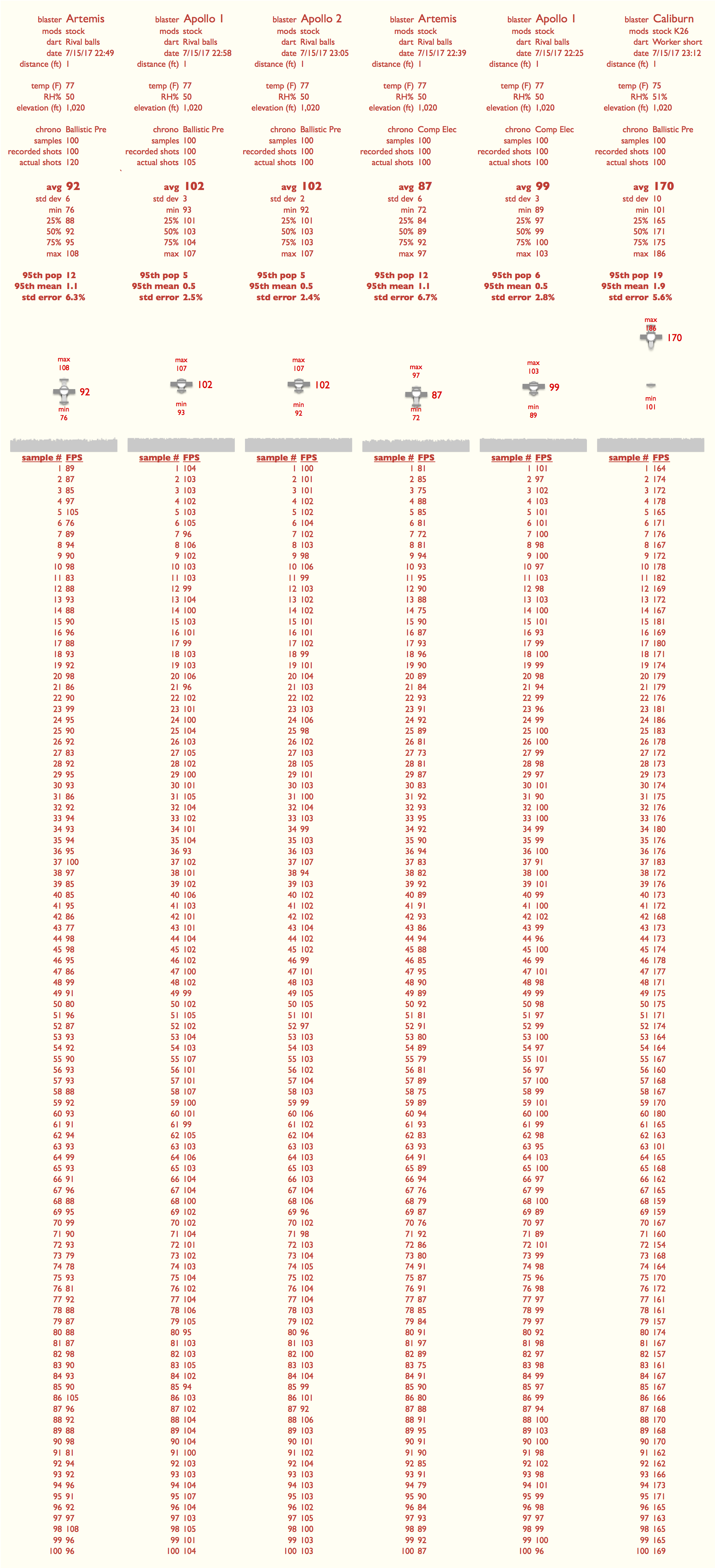In July of 2017 I acquired 2 Rival Apollo nerf blasters and a Rival Artemis. They were priced right following the Amazon Prime Day sales, and that made for a good addition to the chronograph project. I’ll go into more details on the chronograph profiling on the chronograph mega page, but I’ll summarize the Rival Apollo and Artemis performance metrics below.
Chronograph results
I profiled two Nerf Rival Apollos and a Nerf Rival Artemis on my Caldwell Ballistic Precision Chronograph and my Competition Electronics ProChrono. I used the data collection interface on the CBPC and the Competition Electronics Digital Link Bluetooth Adapter. I collected 100 samples for each blaster. I provided the detailed statistics on the data collection runs below.
Caldwell Ballistic Precision Chronograph
I profiled all three Rival blasters on the CBPC. The summary of what I saw was:
- Nerf Rival Artemis: 92 +/- 12 fps
- Nerf Rival Apollo #1: 102 +/- 5 fps
- Nerf Rival Apollo #2: 102 +/- 5 fps

A few observations:
- The Nerf Rival Apollo reproducibility was impressive. The 25th, 50th and 75th percentile spreads were within 2 to 3 fps of each other. This is a very consistent blaster, so much so, that I have chosen it as my reference blaster that I’ll use for long term baselining of my chronograph setups.
- Both Apollos yielded the same average FPS. I was not expecting this level of consistency across blasters. I may have to watch for additional sales to pickup a few more blasters to see if this consistency continues across additional blasters. It will also be interesting to see how these numbers hold up over time on the same blaster.
- The Nerf Rival Artemis came in about 10 FPS lower than the Apollos, as expected. The variability in the shot results was higher, showing both a wider maximum spread, as well as a broader separation between the 25th and 75th percentile values (88 to 95). Overall performance was good though, showing more consistency than what I typically see in stock elite blasters.
Competition Electronics ProChrono Results
An element of my chronograph project involved the addition of a second chronograph to my collection so I could collect additional data for comparison to my first chronograph. I added a Competition Electronics ProChrono because that seems to be the other popular chronograph in use within the Nerf hobby. I profiled one of the Nerf Rival Apollo blasters and the Rival Artemis blaster on the CEP:
- Nerf Rival Artemis: 87 +/- 12 fps
- Nerf Rival Apollo #1: 99 +/- 6 fps

What you’ll notice is the results came in slightly lower on the CEP compared to the CBPC. I’ll dig into these results in more detail here, but we can see that the confidence intervals were about the same on the population and averages, indicating the performance of the blasters was similar from a spread perspective, just shifted lower. The difference between the average values is statistically significant, but I can’t tell you which chronograph is a better representation of the actual FPS, just that they yielded different results.
Full data sets
I’ve provided an image of the full data sets collected during this profiling run. I also profiled my Caliburn during this benchwork.

